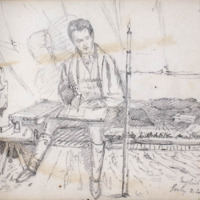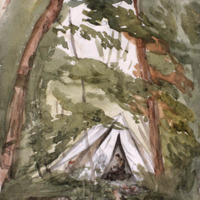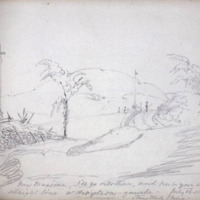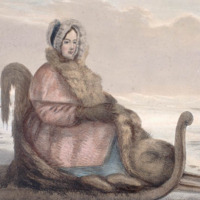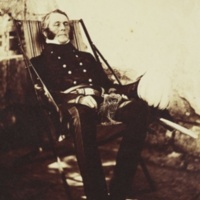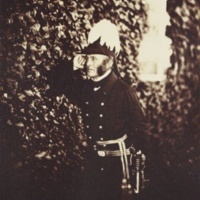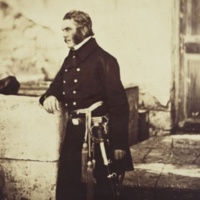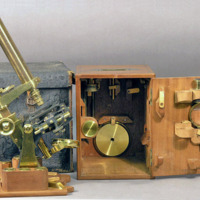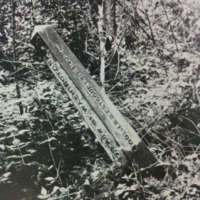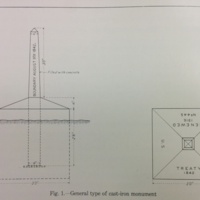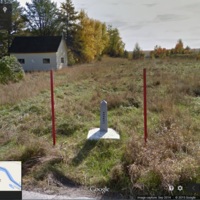Original Findings: Making His Mark
"The Government could not supply a better man"
How was Estcourt set on the path that would lead to his name being immortalized on a monument? James Bucknall Bucknall Estcourt was born July 12, 1802 into a well-off family, his father being an MP. After gaining an education, Estcourt entered the profession that many second sons undertook: he joined the army. He served in Ireland, England, Gibraltar, and the Canadian colonies. Along the way he engaged in surveying roads in Canada, and served as second-in-command of the Euphrates surveying expedition, giving him some qualifications for the post of joint boundary commissioner. His position as an officer was also in his favour, as government officials believed there would be a "greater dignity" in sending a man from England instead of appointing a "mere surveyor or astronomer from Canada or New Brunswick." However, his biggest advantage was that his brother-in-law was the Permanent Under-Secretary for Foreign Affairs, and suggested him for the job.
Estcourt expressed doubts about the depth of his engineering and surveying knowledge - despite his experience he was not confident in his abilities to meet the responsbilities of such an important position. In fact, he so emphasized his shortcomings that the Foreign Secretary had doubts about appointing him commissioner. It was the testimony of his colleagues that "the Government could not supply a better man" that secured him the position.
"No exertion should be spared on my part"
Estcourt assured his brother-in-law that "no exertion should be spared on my part," and indeed the boundary marker's existence is testament to his efforts as commissioner. From the moment he was offered the position, he began studying the science and technique of surveying to improve his understanding. He consulted astronomers at the Royal Observatory as well as other experts to ensure the commission had the best possible instruments. While still in Great Britain he began to plan a strategy for surveying the territory, and upon his arrival found that the locations he had picked for supply depots were all suitable. This was a man who prepared himself for what lay ahead.
Estcourt was just as involved once the surveying began. As commissioner he attended meetings with officials and could expect certain preferential treatment, but he also worked hard with his men. An American news correspondent reported that while the American commissioner rode in the stagecoach, Estcourt walked at the head of his party. Estcourt wrote that one time they "cut not only an occasional interfering tree, but so many, that I was fairly beat, and obliged twice to lay down and sleep, and so did not reach the encampment for more than one hour after the main body of the men."
Considering his hands-on approach, it is no surprise that it was Estcourt's decision for the monuments to be cast-iron. He wrote to his superiors about the advantages of his suggestion: the monuments would be fireproof; they would be identifiable in the wilderness; they could be easily transported; and they would be cheaper compared to stone. The monuments were made in Boston in a six-foot version and an eight- or ten-foot version (sources are not clear). The larger ones were installed at specific key points, while the smaller ones were placed along the whole border. The ones that went on islands were embossed with "US island" or "HBM [His British Majesty] island." Accordingly, this specific monument would have been one of the hundreds that were on the regular land boundary.
Estcourt's planning was also responsible for the distribution and installation of the monuments. They were usually brought by boat to various locations where wagons picked them up and brought them to the line via specially cut openings. The terrain in the highlands was so swampy and rough that Estcourt arranged for the markers to be distributed in the winter, when snow made it possible for the men to drag them on toboggans. It was a necessary but brutal task, as described by Estcourt: "The service was one of sever labour and exposure. Sometimes all hands were required to haul each monument in succession up a precipice; sometimes a violent snow-storm would cross the hills where the men were at work; and they would scarce be able to keep body and soul together."
Once in place, the markers were secured by burying them three feet deep in regular ground, by putting them over cedar posts in swampy ground, or by nailing them with fox wedges into rocky ground. The side with “ALBERT SMITH U.S. COMssr” faced American territory, while the side with "LT. COL. J.B.B. ESTCOURT H.B.M. COMssr" faced British lands.
"A perfect gentleman"
When Estcourt's brother-in-law was writing to other government officials about hiring a comissioner, he commented, "What an awful life the wretched people employed on this service will have to lead for two or three years!" But what did Estcourt make of his situation? Estcourt's official narrative of the commission shows his businesslike attitude, but his letters and writings reveal the person behind his military demeanour.
The surveying life did indeed have unpleasant moments, and Estcourt references the difficulties of working in extreme heat and cold, finding enough workers while keeping costs down, and facing plagues of mosquitoes. His British sensibilities were offended by the houses and people he described as "dirty." But he also respected the Canadians for the hard-working and willing natures. He appreciated the beauty of the Canadian wilderness, and took back to England pressed maple leaves.
Estcourt could be quick to judge, and condescendingly described the American commissioner Smith as "not the least gentlemanlike in appearance, very little so in manner." He was also willing to change his mind, admitting that "he improved rapidly" upon acquaintance. They had a friendly working relationship, which made the commission progress smoothly and allowed Estcourt to enact his ideas on things like the monuments. Estcourt had an equally respectful relationship with the men under his command. Although he describes the occasional "blow up," he notes they parted on "excellent terms."
Estcourt was a religious man, and lived by his principles. The Supplement to the Quebec Mercury recorded that he donated £60 to help victims of a serious fire in May 1845. This money-spending, however, doubtless contributed to the debts he owed in England, which his father and brother managed for him.
Above all he valued his family. He exchanged countless letters with them, reminding them that "I love a prosy letter from home." He wrote that his chief satisfaction in being commissioner came from pleasing his father. And Estcourt was devoted to his wife Caroline, who was an independent and adventurous woman. She accompanied him on many of his postings abroad, and was a talented painter and amateur naturalist.
One of the labourers on the commission described Estcourt as follows: "High and honourable in his feelings, kind and affable to all, of strict religious principles; he was esteemed and loved by all who knew him. No man ever made a more conscientious discharge of his duties than this officer."
Of Monuments and Men...and Museums
The boundary monument and Estcourt became inextricably linked when he became the joint boundary commissioner, deciding how it would be made and delivering it to its rightful place. Except he returned to England, ultimately dying in 1855 while serving in the Crimean War, and the monument remained here, their only visible connection becoming his name on its side. The man left behind the monument, but how did the monument leave its post to go to a museum?
This remains, to an extent, a mystery. In the decades following the joint boundary commission, the boundary was reviewed and maintained through further treaties, culminating in the International Boundary Commission that does the job today. Reports on the boundary kept careful track of each monument's location. In 1908 it was agreed that where possible all original iron monuments should be filled with and set in concrete on their original location. Furthermore, all the markers were to be stamped with a number identifying their position along the border. This specific monument has no visible number markings, so does this mean it was removed before 1908? And if so, how did it end up in the hands of Lambert before arriving at the museum?
Although these important questions still await an answer, they must not detract from what has been discovered. This monument serves as a gateway into the life of Estcourt, and learning about his role in the commission in turn sheds light on the monument's story. Now we can picture Estcourt planning it, the Bostonians making it, and the labourers transporting it through adverse conditions.
At first glance the survey marker appears to just be an iron obelisk. But a second reading shows there to be a name. And behind that name, a whole life to discover and give this hollow monument meaning.
